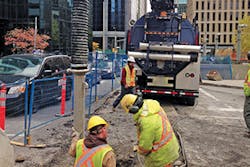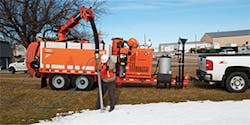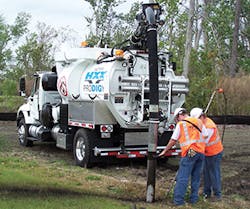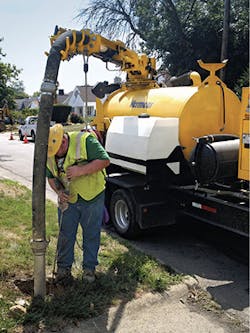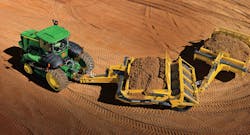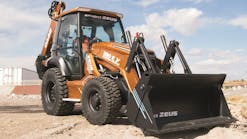Customers for this technology appear to be targeting larger truck-mounted units for increased productivity and flexibility, says Ben Schmitt, product manager, Vactor Manufacturing. “The biggest trend is just the growing awareness of hydro excavation over conventional mechanical means.”
Vacuum excavation equipment uses high-pressure air or water to control soft excavation—frequently to safely locate and uncover underground utilities. Spoil is sucked through a vacuum hose and is deposited into a debris tank for later disposal, or for backfilling into the hole. Models range from large dedicated truck units to small trailer- or skid-mounted units, which gained popularity in the 1990s as support machines for horizontal directional drilling operations. The smallest vacuum excavation units even fit into the back of a pickup truck.
Vac-Con Inc. is one of the companies that grew up alongside the increasing use of vacuum excavation. The company was established in 1986 to develop a truck-mounted combination sewer and catch basin cleaning machine to compete in the government and private contractor market segments. The founding philosophy was to provide powerful and efficient equipment that was easier to use and easier to maintain.
While adhering to that philosophy, Vac-Con has expanded its product line to include industrial vacuum loaders and vacuum excavators, and has manufactured and distributed more than 7,000 machines, worldwide. Vac-Con started building vacuum excavation machines for the oil fields of Western Canada in the early 1990s, to be used in the standard “daylighting” process, as well as slot trenching operations. As the industry grew, the excavation market expanded to include municipal water authorities and major utilities, and ultimately to support the construction industry in a number of aspects, including directional drilling and underground utility locating, repair, and installation.
Vac-Con now has a wide range of experience, from the simplest auxiliary hydro excavation packages on municipal combination machines, to the industry’s most powerful dual-blower machine with sophisticated hydrostatic drive and control systems for heavy excavation projects. The Vac-Con X-Cavator is being used throughout the US and around the world. Vac-Con machines are built in the United States at its manufacturing facility located in Green Cove Springs, FL.
Some utilities, transportation departments, or power plants specify air vacuum excavation for a number of reasons. Air vacuum excavation is desired in applications where the soil is loose, water is not readily available, or where immediate backfill of the hole is required. When working around buried electrical lines or brittle utilities, air vacuum excavation is often preferred due to the lower operating pressures.
Schmitt says the utility segment appears to amount to about 20% of the total vacuum excavation market. However, demand continues to increase rapidly in the oil and gas production sector.
“We have seen a great deal more regulations and requirements on methods of excavation near identified utilities and an increased focus on safe digging, which has been driving more need for vacuum excavators over the past four years,” says Jeff Wage, vice president of sales and marketing for McLaughlin, which manufactures the line of Vermeer Vacuum Excavators. “The increase in demand continues at an accelerated rate for this technology.”
Wage says he sees more focus on core drills for cutting a core in a road before potholing, which reduces time and excavation size and improves reinstatement of the pavement. “Moreover, we see a trend toward more 4-inch vacuum systems for potholing utilities and for staying on the job longer with larger tank capacities,” says Wage. “We see more users going to a four-inch suction hose and 50-hp-class machines with 1,025 cfm blowers to handle larger material and improved productivity. We also see this segment migrating toward diesel power for higher torque curves versus gasoline, while value priced gasoline vacs in the 25 to 30 hp class remain the norm for mud-sucking in horizontal drilling applications.”
Opinions differ about whether demand is increasing faster for air or water-based vacuum equipment, but each has its place. “Over the past five years, the industry has trended more toward using water than air,” says Jason Proctor, vacuum excavators product manager, Ditch Witch. He says dry spoil is highly preferred, but water is more effective in most soil types. Ditch Witch vacuum excavators currently use hydro excavation technology (water). “Other trends include larger spoils tanks, greater selection of optional features, and increased levels of performance,” says Proctor.
“Air is safer and more economical,” says Trevor Connolly, vice president of marketing for Vacmasters. “Although typically a contract may only require a company to use vacuum excavation in general, there are more and more areas popping up that have jobs demanding air excavation. The problem with hydro excavation is that it uses water as its digging medium,” says Connolly. “In geographical areas that suffer from drought, it is virtually impossible to supply these hydrovac units with enough water to complete a job.”
Connolly says air is much cleaner and environmentally sound. With air, one is not adding any mixture to the soil and therefore will not spread a potential contamination plume into the soil. When using air, Connolly says one can simply use the dry dirt in the spoils tank as backfill. But with a water-based unit, you have to haul the muddy spoils to the appropriate dump site—which adds considerable time and cost.
The most basic difference between air and water is that air is a compressible gas, while water is a non-compressible liquid. “This irrefutable fact makes air much safer to use in vacuum excavation than water,” says Connolly. “When air hits something solid, like a buried utility, it will compress and flow around the utility. Water, on the other hand, being non-compressible, will try and cut right through it. That is why water is used to cut sheet steel and air is not.”
Badger Daylighting LP, with US headquarters in Pittsboro, IN, manufactures hydro excavation machines for its own use and offers excavation services. Badger owns more than 950 hydrovac machines working from 110 locations in North America. Most of the units are mounted on tri-axle trucks, but they have dual-axle and single-axle trucks as well. The company does not offer its machines for sale, but rather provides hydrovac services to customers with trained, competent operators on a 24/7 basis.
“When you see the productivity that you can achieve with the higher-efficiency vac machines, you start to realize that the costs on many of your projects can be less with a hydrovac than with other methods of excavation,” says Mark Lyle, director of corporate business development for Badger Daylighting. “So now you’re combining enhanced safety with lower costs and more productivity. When you combine those three things, people start utilizing hydrovac more often in different ways.
“You can do test holes, and you can do slot trenches that are two inches wide up to many feet wide,” says Lyle. “You can dig quite deep. With our more efficient trucks we have excavated many projects over 20 feet deep and we have done debris removal for pilings that are over 50 feet deep. We’ve even removed water from 500 feet vertically from a mine.
Vermeer Air Vac
“You can remove debris in a number of different scenarios,” says Lyle. “It could be from a flood, or it could be from a culvert. We’ve removed debris from more than 1,000 feet, horizontally. And then you get into pits. That’s usually where you dig down to do repair or maintenance work. That’s another major application. Probably the last one would be piling holes or utility pole holes. So those would be the five main applications, but they’re not limited to one particular industry. A variety of customers can utilize all those applications, whether it’s a gas utility or an electric utility, oil and gas facility owner, or contractor. You name the industry and those types of applications pretty much apply in all of them.”
Rick Wayman works for Tri-County Electric Cooperative Inc., based in Hooker, OK. The utility uses a Ditch Witch FXT-50 vacuum excavator to do line locates for its own underground construction projects. The most frequent application is to locate utilities and dig a hole for utility poles. Most holes are six to six and a half feet deep, and 18 inches in diameter.
We asked Wayman how he likes the FXT-50 machine. “It’s working very well for us,” he says. “I’d say we use it at least once a week on one project or another. Last week, we were locating phone lines with it to be able to bore a line through a road intersection. We’re building a new office facility and we were locating the phone lines and fiber optic and gas lines with it so we could run the bore under the intersection. We put an 8-inch steel casing underneath the road.” The project required seven or eight potholes, says Wayman.
Ron Berens, owner of HydroVac Solutions, Selkirk, Manitoba, Canada, uses Ring-O-Matic vacuum excavation equipment to help in repairing residential water service boxes for the city of Winnipeg. Crews commonly operate the machine in subzero temperatures and cut down through four feet of frost in the soil.
“The boxes break, or they shift, and we can’t turn the water on and off anymore,” says Berens. “We have to take out the old boxes and put in new ones so they can operate the water valves again. We just dig the holes. Since January 1, we have probably dug 200 holes for the Winnipeg Water Division.
“We use hot water on the Ring-O-Matic machine,” says Berens. “The water runs between 100 and 150 degrees Fahrenheit. We have burners to heat the water on all three vac trucks. Otherwise you wouldn’t be able to dig in the frost at all, not without hot water. If there are cables, we turn the temperature down to 100 degrees Fahrenheit. If there are no cables, we’ll run about 150 degrees. It only takes us about 20 minutes to dig one hole.” The 8-inch holes go from 6–9 feet deep.
Two of the Ring-O-Matic units that Berens operates are mounted on a triple-axle trailer and one is mounted on a tandem-axle trailer. The capacity of the two larger units is 1,300 cfm and they have a 1,300-gallon debris tank. The smaller machine has an 800-gallon debris tank and holds 500 gallons of fresh water.
Berens likes the trailer-mounted units because he pulls them with a dump truck that contains sand for backfilling. “We shovel sand into a wheelbarrow and then shovel it into the hole.” In addition to working for the city of Winnipeg, Berens works for some 20 construction companies that need to expose utilities for onereason or another.
“We do a lot of work for Rohl Construction, and they have five or six directional boring machines,” says Berens. “We’ll go ahead of the boring machines and expose the utilities—the power company, the gas company, the gas company. They mark utilities with paint or flags if there’s snow on the ground.”
Potholing in the Desert
“I’m an owner, but I’m also one of the operators. When we show up on the job, you’re getting the owner of the company and a crew that has pride in what they do,” says Michael Magill, co-owner of Desert Boring Excavation LLC, Coolidge, AZ.
Desert Boring’s services include directional drilling, pit digging, utility locating, and potholing, which has become the bread and butter of the company. Potholing for residential customers, utilities, and even engineered canal systems—with vacuum excavators—has grown in popularity in the Grand Canyon state.
One of Desert Boring’s primary clients is the city of Florence, AZ, a town of approximately 25,000 in the south-central part of the state. Desert Boring was contracted by the city primarily to work with the water and wastewater departments. A majority of the potholing work is focused on assisting the water department in repairing leaks.
In an effort to prevent shutting down service to an entire neighborhood, the city of Florence prefers to perform maintenance without disabling the water system; it is this continual flow of water during the repair process that requires the use of a vac.
Desert Boring will typically show up at the job site with its Vermeer by McLaughlin V800 LEHD vacuum excavator in tow. They will then use their McLaughlin Verifier G2 locator to identify where the utility lines run and use this location to excavate with their vac at the verified utility location. However, in the event that the leak has been flowing and the ground is too saturated, the crew does not have the luxury of time and will have to move in quickly with the vacuum excavator.
Once the material has been removed and the water pipe has been exposed, then the line can be repaired. Most of the lines that need to be repaired are 1.25 inches or smaller. Desert Boring will vac a large pit that is either 4 by 5 feet or 4 by 6 feet; then they will remove all the material so the utility can actually cut the line at the leak and install a compression-style valve in the line. Nonetheless, when the pipe is cut, the vacuum is in place to suck up the water as fast as it is coming out to help maintain a workspace.
To handle the hefty volume of water that the company deals with at many of its job sites, Desert Boring has had to increase the capabilities of its vacs. Originally, they rented an 800-gallon, low cfm vac with a 400-gallon water tank; after only two weeks of rental, Magill noticed the value and didn’t hesitate to invest in the larger vac. As the work began burgeoning and larger equipment became necessary, Desert Boring purchased a Vermeer by McLaughlin V800 LEHD high cfm vacuum excavator.
“It made an absolute world of difference,” says Magill. “When there’s a line that the utility company has cut through and you’re sitting there sucking up 2 inches of water blowing out of a pipe, in a 500-gallon system, you might only get 45 to 50 seconds before the vac is full. If it is an 800-gallon vac, you’re able to go two minutes to two and a half minutes. It may not sound like a lot of time, but when you have somebody in the hole that’s trying to put a fitting on a line, that’s all you need,” says Magill.